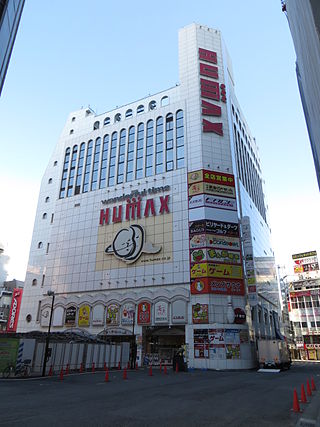
Roppongi is a district of Minato, Tokyo, Japan, famous for the affluent Roppongi Hills development area and popular night club scene. A few foreign embassies are located near Roppongi, and the night life is popular with locals and foreigners alike. It is in the central part of Tokyo, south of Akasaka and north of Azabu.

Shinjuku, officially called Shinjuku City, is a special ward of Tokyo, Japan. It is a major commercial and administrative center, housing the northern half of the busiest railway station in the world as well as the Tokyo Metropolitan Government Building, the administrative center of the Tokyo Metropolitan Government. As of 2018, the ward has an estimated population of 346,235 and a population density of 18,232 people per km2. The total area is 18.23 km2. Since the end of World War II, Shinjuku has become a major secondary center of Tokyo (fukutoshin), rivaling the original city center in Marunouchi.

Special wards are a special form of municipalities in Japan under the 1947 Local Autonomy Law. They are city-level wards: primary subdivisions of a prefecture with municipal autonomy largely comparable to other forms of municipalities.

Ikebukuro is a commercial and entertainment district in Toshima, Tokyo, Japan. Toshima ward offices, Ikebukuro Station, and several shops, restaurants, and department stores are located within city limits.

Shinjuku Ni-chōme (新宿二丁目), referred to colloquially as Ni-chōme or simply Nichō, is Area 2 in the Shinjuku District of the Shinjuku Special Ward of Tokyo, Japan. With Tokyo home to 13 million people, and Shinjuku known as the noisiest and most crowded of its 23 special wards, Ni-chōme further distinguishes itself as Tokyo's hub of gay subculture, housing the world's highest concentration of gay bars.

Takadanobaba is a neighborhood in Shinjuku, Tokyo, Japan.

Kabukichō is an entertainment district in Shinjuku, Tokyo, Japan. Kabukichō is considered a red-light district with a high concentration of host and hostess clubs, love hotels, shops, restaurants, and nightclubs, and is often called the "Sleepless Town". Shinjuku Golden Gai, famous for its plethora of small bars, is part of Kabukichō.

Shin-Ōkubo Station is a railway station on the Yamanote Line in Shinjuku, Tokyo, Japan, operated by East Japan Railway Company. Opened on November 15, 1914, it is close to the large local Korean ethnic neighborhood. Shin-Ōkubo Station has only one exit.

Yūrakuchō (有楽町) is a business district of Chiyoda, Tokyo, Japan, situated in between the Ginza and Hibiya Park, southeast of the Tokyo Imperial Palace. The district takes its name from Oda Nagamasu (1547–1622), who was also known as Yūraku (有楽). Oda Nagamasu built his mansion here on land granted by Tokugawa Ieyasu near the Sukiya-bashi Gate of Edo Castle. The place name dates from the Meiji period.

Seibu-Shinjuku Station is a railway station in Shinjuku, Tokyo, Japan, operated by the private railway operator Seibu Railway. It is the terminus of the 47.5 km Seibu Shinjuku Line, which extends to Hon-Kawagoe in Saitama Prefecture.

Kōenji (高円寺) is a district of Tokyo in the Suginami ward, west of Shinjuku. The district's name originates from the old temples in the area.

Shinjuku Southern Terrace is a commercial zone located at Yoyogi 2-chōme, Shibuya, Tokyo, at the western side of Shinjuku Station Southern Exit. It was built above the Odakyu Odawara Line, to the west of Takashimaya Times Square across the Yamanote Line, and to the south of Shinjuku Mylord. The location opened in April 1998. Shinjuku Southern Terrace is the southern portion of Shinjuku Terrace City, a continuous piece of real estate property owned by Odakyu Group in and around Shinjuku Station.

The Myojo 56 building fire was a structural fire that began at about 01:00 local time on September 1, 2001 in the Myojo 56 building, located in the Kabukichō section of Shinjuku, Tokyo, Japan.

Ōkubo Station is a railway station on the Chūō-Sōbu Line in Shinjuku, Tokyo, Japan, operated by East Japan Railway Company.

Mejiro University is a private university in Shinjuku, Tokyo, Japan. Established in 1923, it was chartered as a women's junior college in 1963, and expanded into a four-year university in 1994. The institution also has facilities in Saitama, Saitama Prefecture, including the Iwatsuki Campus and the National Saitama Hospital Campus.

The Shinjuku Koma Theater was a major theatre in the Kabukichō, Shinjuku, Tokyo. The theatre opened in 1956 and it had a capacity of 2,088 seats. It was demolished in 2009. The Toho Shinjuku Building currently stands on the theater's former grounds.

Shinjuku Face is an event hall located on the 7th floor of the Humax Pavilion Shinjuku complex, 1-20-1 Kabukicho, Tokyo, Japan. It mainly hosts mixed martial arts, boxing and professional wrestling events. Shinjuku Face has a capacity of approximately 600 people.

The Godzilla head is a landmark and tourist attraction in Kabukichō, Shinjuku, Tokyo, Japan. The sculpture is accessible from the Hotel Gracery Shinjuku's Godzilla Terrace, on the Shinjuku Toho Building. It depicts Godzilla, occasionally with "glowing eyes and smoky breath". The 80-ton head, based on Godzilla's appearance in Godzilla vs. Mothra (1992), was unveiled in 2015. Its placement on the Hotel Gracery terrace matches Godzilla's 50 meter height seen during the Showa era films in the franchise.

Kamurochō is a fictional district of Tokyo from Sega's Yakuza media franchise. It is modelled after Kabukichō, Tokyo's renowned red-light district and entertainment precinct situated in Shinjuku ward. Like its real world counterpart, there are many retail shops, izakaya, restaurants, and mizu shōbai establishments like host and hostess clubs, soaplands, and nightclubs within the district. Kamurochō has appeared as the primary setting in most Yakuza main series titles and several spin-off games, as well as adaptations of the franchise in other media.

Tokyu Kabukicho Tower is a 48-storey skyscraper located in the Kabukichō district of Shinjuku, Tokyo, Japan. The 225 m (738 ft) tower was designed by Yuko Nagayama & Associates and developed by Shimizu Corporation. It was completed in 2023 as Japan's 19th tallest building.




















